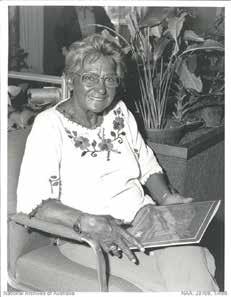
2 minute read
Kath Walker
Lance Corporal Kathleen (Kath) Walker, c. 1942
Oodgeroo Noonucca
Advertisement
Born in 1920, Kathleen Walker, nee Ruska, grew up on North Stradbroke Island in Moreton Bay, east of Brisbane. Known as Kath, Walker showed a natural gift with words at an early age and was encouraged to pursue writing at school. Her father, Edward, worked for the Queensland government and campaigned relentlessly to improve conditions for Aboriginal employees.
Walker left school in 1933 at the height of the Great Depression to take up work in domestic service. When the Second World War broke out in 1939 two of Walker’s brothers, Eric and Eddie, enlisted for service in the army. Both were captured by the Japanese when Singapore fell in February 1942, and they spent the next three and a half years as prisoners of war.
In December 1942
Walker joined the Australian Women’s Army Service (AWAS) and trained as a signaller. In that same year she married her childhood friend, Bruce Walker, who was a talented bantamweight boxer and a welder by trade. Kath remained in the AWAS until early January 1944. She settled in Brisbane with her husband, and their first son, Denis, was born two years later. Both Eric and Eddie survived the war and returned home to Australia. Eddie, who had been a promising sportsman, had lost his right leg during his imprisonment. Walker separated from her husband soon after the war and returned to domestic service to support her son. She gave birth to a second son, Vivian, in 1953.
In the 1960s Walker began to develop a reputation as a poet and published three critically acclaimed collections. Around this same time, she became an increasingly passionate advocate for Aboriginal rights, and worked towards reconciliation for the remainder of her life.
In 1970 Walker was appointed a Member of the British Empire for her services to Aboriginal people. Now known by her traditional Aboriginal name, Oodgeroo Noonuccal, she returned her award some years later in protest against the celebrations planned to mark 200 years since the arrival of the first convict ships in Australia.
She died in 1993 at the age of 72. A trust was established in her honour to carry on the work she had begun towards reconciliation.

To commemorate ANZAC Day on 25 April, this article provides an overview of Aboriginal and Torres Strait Islander involvement in the armed forces and reflects on key themes and legacies of that involvement. ANZAC stands for the Australian and New Zealand Army Corps. ANZAC day is held each year on 25 April. This date marks the anniversary of the first military action fought by Australia and New Zealand, at Gallipoli (Turkey) during World War 1 in 1915. ANZAC day was first celebrated in 1916. Over the years, the rituals and observances held each ANZAC day have developed into what they are today –including the dawn service, marches, memorials and more. The day has also become a commemoration of all wars Australia has participated in and a time to reflect on war and its legacy.








